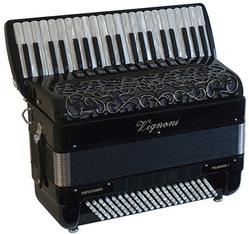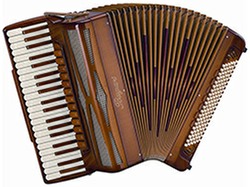The ACCORDION LOUNGE Much Wenlock Shropshire UK | © The Accordion Lounge 2016 - 2025 All Rights Reserved



OPENING TIMES
Tuesday to Saturday: 10:00am to 4pm
Sunday & Monday: By arrangement
Please note that visits are by appointment


07533 930603
accordionlounge@outlook.com

Buying an Accordion?


Compact 120 Bass Accordion




Home > Buying an Accordion
The growing use of materials such as “acoustic woods” has increased the availability of lighter accordions - several manufacturers now offer full size 120 bass accordions that weigh around 10 Kg. One even weighs in at just 9.4 Kg!
• Accordion Brands
Accordions are manufactured in various countries - Italy, Germany, Czech Republic, China etc. - and quality varies considerably.
Eastern European and Chinese accordions are often cheaply mass produced, and whilst rugged, their build, playing and sound qualities are very variable.
Italian accordions are widely considered to be the best, offering superb craftsmanship and sweetness of tone. It is rare indeed to come across a poor Italian accordion. Italian brands are highly regarded and well cared for instruments are often easier to resell and command higher second hand prices than accordions made elsewhere.
Italian accordions are most often labelled “Made in Italy” or “Castelfidardo” - it is not unknown for accordions manufactured in Eastern Europe or China to be branded with Italian sounding names!
• Try before you buy
Try as many accordions as you can before deciding which one to buy.
Every accordion has it’s own “feel” - it is important that the instrument is comfortable and the action of the keys and buttons suits you - you are going to spend many hours strapped into it!
When you have decided on an accordion, check it is in full working order, in tune and if buying from a dealer, is offered with a guarantee (particularly important with used accordions).
• Trusted Seller
For peace of mind buy from a reputable dealer or someone you know and trust.
Reputable dealers value your business and offer after sales services. They also guarantee the instruments they sell.
We would advise caution when using online auction sites as the true condition of accordions advertised for sale is unknown, and there are no guarantees or after sales support. However, with care, and if you are willing to take a risk, bargains can be found.
• Buying an Old (Vintage) Accordion
Accordions over 25 to 30 years old inevitably start to require significant maintenance. For example, the wax that fixes the reeds to the reed blocks generally lasts around 30 years so may need replacing, reed leathers will have deteriorated, the bellows might be worn out or damaged etc. They are also likely to be out of tune!
Old unrestored accordions are often advertised for sale at bargain prices. Before buying an old “cheap” accordion, we advise you assess its condition to decide whether it is of sufficient quality to warrant the cost of repair/restoration.
If you are considering purchasing on old accordion, to gauge its condition we recommend:-
- Checking for leaks in the bellows.
- Listening for rattles when playing - indicative of reeds that have broken free from their wax.
- Checking that all the notes are sounding and their are keys operational.
- Playing every note to see if the sound when opening the bellows is the same as when closing the bellows - out of tune notes will be fairly obvious.
- Playing octaves of each note, e.g. middle C and top C together - they should be in tune to each other.
- Checking the treble keys are level, bass buttons do not stick, and coupler switches work.
- Smelling the accordion - a musty odour suggests internal mould and rusty reeds. Restoring and re-tuning rusty reeds can be costly.
Accordions that have been played regularly are likely to have been well maintained and generally offer the best deal. An instrument that has been untouched for many years will have deteriorated through lack of use, zero maintenance and more often than not, been stored in poor conditions. In most cases, these accordion are best avoided.
If you are new to the accordion, the variety of instruments available - brand, size, keyboard types and layout etc. - can seem bewildering.
Advice to help you select a suitable instrument is freely available from many sources, but ultimately your decision as to which accordion to purchase is one of personal taste and budget.
To help you decide which style of accordion might suit you best, here are a few points you may wish to consider:-
• What type of music do you like to play?
This will influence the size (number of bass buttons) and tuning of the accordion.
96 or 120 bass accordions offer greater flexibility than smaller instruments which may limit your repertoire.
If you like to play popular styles of music (e.g. French) a musette accordion would be preferable to a straight tuned accordion which is more suited to classical and jazz.
For more information on accordion sizes and tuning please see our Types of Accordion page
• Piano or chromatic button accordion?
This is very much a personal choice. All styles of music can be played on both and each system offers benefits over the other.
If you choose a chromatic button accordion, check which system it uses (B or C) and if you are planning to take lessons, ensure your tutor teaches button accordion and is familiar with your preferred system.
For more information on piano and button accordion please see our Types of Accordion page
• Physical Size & Weight
The physical size and weight of an accordion is an important consideration as you need to be able to comfortably manage and control it when playing, whether sitting or standing.
48 bass accordions are very compact and lightweight. They are ideal for beginners and young accordionists.
72 bass accordions are a good mid-range size and are lightweight. Well-suited to adult beginners they are a good compromise of size and weight, although may limit your repertoire through a lack of notes.
96 bass accordions are relatively lightweight and offer great scope and flexibility in a reasonably compact package.
120 bass accordions offer the greatest scope and are the largest and heaviest stradella bass accordions.
Piano accordions of any size (number of bass buttons) tend to be physically larger but lighter than their chromatic button counterparts. Since the buttons on a button accordion are positioned close together, a more compact instrument results. However, the compact button keyboard allows the inclusion of more notes than on a piano keyboard - consequently, although smaller, button accordions can be heavier than their piano equivalents.
Many manufacturers now offer “compact” piano accordions whereby the features of a larger instrument are fitted into a smaller body than normal. For example, a 120 bass fitted into a similar sized body to that of a 96 bass accordion. Although physically smaller, the resulting accordion is not always significantly lighter than one of conventional size.
























